Elemental Cycle – Pack 1 - Breath of the Kami
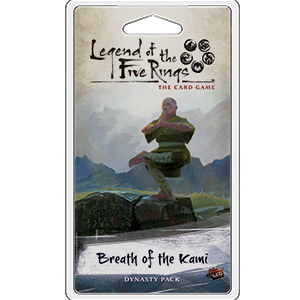
The first pack of the elemental cycle is focused on the element of Air. We got the team together to go through the cards in the pack.
01. Hisu Mori Toride
Hisu Mori Toride is a small village near the City of the Rich Frog where the Unicorn and Lion are currently fighting. This stronghold represents the Lion army taking and holding that village as detailed in the Family Duty story from the Into the Forbidden City dynasty pack.
Hisu Mori Toride has 1 less influence and 1 less starting honor than the original Lion stronghold, Yōjin no Shiro. Its effect is also markedly different. Instead of aiding in military attacks as Yojin no Shiro does, Hisu Mori Toride rewards its player with an additional military conflict. Winning a military conflict by 5 more or skill (on the attack or defense) and sacrificing a Bushi will provide a Hisu Mori Toride player with an additional military conflict. This can allow them to sidestep attacking via political conflicts altogether, or, with a sufficient number of characters, to engage in up to three attacking conflicts per turn: two military and one political. It also means the Lion player will always have the last conflict. This forces the opponent into the difficult position of deciding between leaving characters unused or leaving their provinces undefended against a surprise attack from a Vengeful Oathkeeper (who now will always have a military conflict to attack into). Hisu Mori Toride will probably only be used to take an extra province once or twice a game, but its potential to do is impactful every turn.
The cost of sacrificing a Bushi isn’t terrible since Lion regularly field cheap ‘throw-away’ characters without fate. But the sacrifice of a more expensive Bushi can be turned to the Lion player’s advantage with cards like Kitsu Spiritcaller. Not only can a Lion player potentially get a powerhouse like Honored General into two military conflicts in a one turn via the Spiritcaller’s ability (attack with General, sac General, resurrect him in the second military conflict), that player can adopt a more conservative, value-oriented game by circumventing the Spiritcaller’s ‘return it to the bottom of its deck’ clause. In this case, the Lion player resurrects the General in their first military conflict, then sacs him to trigger Hisu Mori Toride’s ability. General will go to their discard pile, and – because he is out of play when the conflict ends – he does not get placed on the bottom of the deck, meaning he is available to be brought back by the Spiritcaller on following turn(s).
The stronghold also works extremely well with Sashimono, which prevents characters from bowing as a result of conflict resolution in military conflicts. The bigger the character, the better, and with the extra military attack from the stronghold, a single powerhouse character can participate in up to three military conflicts in total during a single turn. If this is a strategy you’re pursuing, you may want to keep your political conflict till last, so you can maximize your power – character’s impact over as many conflicts as possible.
02. Sacred Sanctuary
Sacred Sanctuary is a Dragon-only Air province, which means it would replace Manicured Garden. Its province strength is very low, at 2, but its reaction allows you to straighten a Monk character, meaning that a Monk-focused deck should always have a defender. Sacred Sanctuary further incentivizes defending, because the targeted monk character cannot be bowed by an opponent’s effects and will not bow due to conflict resolution. The dream scenario, then, is to have a big monk who attacks and bows out, followed by an opponent declaring an attack against Sacred Sanctuary. The monk gets straightened, defends, and wins, and then gets to attack again.
Since the ability is a reaction to a declaration of attack, it can be used on subsequent turns – but only once per turn, since it is still limited by standard rules. Without a Monk in play on its controller’s side, however, Sacred Sanctuary is a blank 2-province strength province. Therefore, a Dragon deck will need to field a large percentage of Monks in its dynasty, something that will hopefully prove viable as the elemental cycle develops.
03. Demonstrating Excellence
Demonstrating Excellence is the first in what we believe to be a set of elemental provinces, each featuring an effect that triggers when that province is broken. In addition, each province has +2 strength while their player has a role that corresponds to the province’s element. This mechanic has come under some criticism arguing that one of the strengths of Feast or Famine is its low province strength of 3, which makes triggering its effect more likely. In contrast, Before the Throne has a province strength of 5, making it less likely to break (and trigger its effect). High-strength provinces like this can end up being ‘farmed’ by attackers, who are interested in winning rings and not breaking provinces. Because of this, these provinces may actually see more play ‘out of element,’ as it were.
The effect of Demonstrating Excellence is relatively innocuous: a gain of 1 fate and 1 card, much like a combined Manicured Garden and Fertile Fields, but at the cost of losing the province. This might see some play with an aggressive deck uninterested in saving provinces where the slight gain over other air provinces will prove an advantage.
04. Third Tower Guard
One of the holes in Crabs dynasty is the lack of an aggressive 1 cost character. Third Tower Guard fills that hole to an extent. As another body, she works well with Shiro Nishiyama. Getting more military is somewhat redundant in Crab but the Earth ring is valuable for Crab as their current role is Keeper of Earth while the Water is often a high priority 1st conflict. Ideally, you either do a political conflict for Earth or Water and then have her available as a 3 strength military character or successfully defend an Earth or Water conflict and then have her available for a military counterstrike. She isn’t as powerful as some of the truly exceptional 1 drops such as Bayushi Liar, Doji Whisperer or Matsu Berserker but her balanced stat-line and 0 glory result in a flexible character that can be committed early if you need a probing attack or grows in strength for later in the turn. She will certainly see play, probably replacing a 2 cost Crab or Hida Guardian in Crab decks.
05. Hiruma Outpost
Interesting card. Its honor loss reaction incentivizes you to attack the province a holding is in, however, its province strength bonus makes that a harder province to take. It seems best off sitting in province people are uncomfortable attacking, ideally Pilgrimage where even a token defense will hold off all but the most determined assault, and without breaking the province they cannot resolve a ring. Having it in a province such as Shameful Display, Meditations on the Tao, Defend the Wall or even Before the Throne might funnel your opponent into these provinces which will be tougher to break as a result of the province strength bonus. Crab decks can always Rebuild the outpost into an unbroken province prior to a conflict being declared and can even put it in the 4thprovince before they attack your stronghold. It plays best with other holdings you can sacrifice for effects such as Imperial Storehouse or Favorable Ground so it remains the only holding on the board. Due to the timing, however, it plays more poorly with Iron Mine which you will want to hold onto for later in the turn. It’s not an auto-include, but a deck looking to pressure dishonor that can build a murderers row of provinces can certainly get some real value out of it.
06. Fū Sui Disciple
Fū Sui Disciple has a similar requirement to the Phoenix clan’s Prodigy of the Waves. As long as any player has the Air ring, the Fū Sui Disciple’s player can use its action. Unlike the Prodigy, though, it actually matters which player has the Air ring, since that player will choose one of their characters without a status token to be honored or dishonored. Players may also end up trying to lose Air conflicts while this character is in play, in order to force the Disciple’s ability on an opponent or to escape it.
At 3 fate, the Fū Sui Disciple is a relatively cheap Shugenja (compared to Crane’s other Shugenja), which could help the Crane run a more consistent Shugenja line up. The Disciple’s stat line of 1 military and 2 political skill is more in keeping with a 2 fate character, but the potential skill impact from the ability should quickly make up for this limitation.
07. Matsu Seventh Legion
The Matsu Seventh Legion flies in the face of the notion that design would never print a high military skill Lion character due to Way of the Lion. That said, you pay for it – with the Seventh Legion costing as much as a clan champion. The ‘No attachments except Weapon‘ clause protects the Legion from Cloud the Mind and Pacifism, but it also means that they cannot benefit from a Sashimono.
The no defending Courtiers clause is a big kick for Scorpion and Crane, both of whom field that trait in significant numbers. Phoenix can also be affected, though to a lesser extent, but almost every clan features at least one or two strong Courtier cards, such as Ide Trader, Kitsuki Investigator, or Shrewd Yasuki. Because of this, the Legion’s ability has the potential to be a super Covert, but will more often just be a weaker version. As a Charge! or Kitsu Spiritcaller target, the Seventh Legion is lackluster. On one hand, it does have 7 military skill, but, on the other, its trait is wasted, since defenders will have already been declared. As an additional minor benefit, the Legion’s Cavalry trait gives Lion limited access to cards that require Cavalry, primarily Cavalry Reserves, but more options may open up in future.
08. Isawa Uona
Isawa Uona’s 2/- stats are somewhat weak, even for a 2-cost character, but her ability is incredibly powerful and more than makes up for this shortfall. After you play an Air card during a conflict, she bows a target non-unique participating character as a reaction. This ability is in the same stratosphere as Mirumoto’s Fury and Lion’s Pride Brawler, which are two of the most powerful cards in the game, so Uona immediately demands attention. She does not have to be participating to use her ability, and it can be used on attack or defense. Current Air cards of note include Benten’s Touch, Cloud the Mind, Kaito Kosori, Seeker of Knowledge, and Walking the Way, with more to come in this very pack. She’s an instant auto-include for Shugenja based Phoenix decks, and will radically alter all combat calculations while in play.
09. Soshi Shadowshaper
Scorpion have an impressive selection of Conflict characters, and Adept of Shadows ranks high amongst them. Soshi Shadowshaper gives a similar ability to high utility characters like Meek Informant or influence characters such as Seeker of Knowledge, Iuchi Wayfinder, and Hiruma Skirmisher, allowing you to get the full benefit of their abilities and then return them to your hand for a later use. It also works aggressively, forcing your opponent to repay for their cheap Conflict characters if they are able. It’s a powerful ability that has the potential to swing turns in your favor, though it’s heavily dependant on the decks involved.
Deck space-wise the Shadowshaper has some issues. Currently, Scorpion decks often run Cloud the Mind but beyond that have very little Shugenja synergy. The lack of Courtier hurts a lot and means it’ll often be in contention with Soshi Illusionist, a character with better stats and a weaker but more reliable ability. Until we see more Shugenja synergy the Shadowshaper may be limited to decks that rely on its combo potential, a risky prospect with a 2 cost character. The Soshi Shadowshaper is a good card, but unlikely to be an auto-include yet.
10. Heartless Intimidator
Milling (discarding cards from your opponent’s deck) is a relatively rare ability at the current stage of the game, which actually hurts this card. In isolation, the Heartless Intimidator is unlikely to be able to force the 5 honor loss of a reshuffle. The 3 cost Courtier slot for Scorpion is competitive, and the other three characters (Favored Niece, Shosuro Actress, and Fawning Diplomat) have abilities much more likely to impact the game. Discarding a card from your opponent’s deck has the potential to hit a powerful card, but is effectively just as likely to discard a weak card allowing your opponent to draw a more powerful one. If further support for this archetype comes then the Intimidator may find a deck, but for now, the Heartless Intimidator doesn’t do enough to outshine the other 3 cost Courtiers and currently does very little to help you win the game.
11. Shinjo Shono
The Unicorn Clan has suffered from a lack of quality 4+ cost characters. Thankfully, Shinjo Shono is here to help redress that balance. At 4 military and 3 political skill for 4, along with 2 glory, Shono’s stats are already quite reasonable for the cost. He has Cavalry, always welcome, and Commander, which is an emerging sub-theme. His Pride keyword means that should he win a conflict he becomes honored, vaulting his stats to 6/5, and his ability is tailor-made for winning conflicts. We’ve seen a few Unicorn cards that reference outnumbering, so we can hazard a guess that this is a new mechanical direction for the clan. Assuming this gets the support it needs, Shono fits right into that strategy, both by buffing it and being rewarded for its success. As such, we’d expect to see Shono as a staple character for Unicorn, in much the same way that Honored General has been for the Lion. Unicorn have some way to go to catch up with the other clans, and cards like this will definitely help bridge that gap.
12. Shiotome Encampment
Shiotome Encampment is the Unicorn equivalent of the Crab Clan’s Iron Mine. Where the mine keeps a character around for an extra turn, the Encampment makes one character twice as good this turn. Unlike Iron Mine, Shiotome Encampment does not get discarded after use, but it does require the Unicorn player to have claimed a ring from a military conflict, either on attack or defense. Captive Audience takes on even more importance as a cornerstone card for Unicorn, and can turn unfavorable political conflicts into fuel for Shiotome Encampment’s ability. Straighten effects are hugely powerful in L5R, so this should be an instant staple for all Unicorn decks, as well as a priority target for all opponents. Unicorn could be competitive with a vengeance in a very short time.
13. Kudaka
Kudaka is the first Mantis Clan character we meet, and one of many in this cycle. Her 3/4/1 stats are solid, if not particularly exciting. Her ability, however, transforms the Air ring into a resource-producing wonderland and is going to encourage an awful lot of brewing in the wake of her release. Her reaction means that the Air ring will now reward her controller with an additional 1 fate and 1 card, on top of the potential honor gain for claiming it as an attacker, and she can do this up to twice per turn.
The clans that appear able to benefit from her most are Crane and Phoenix, with Scorpion as a possible third. Crane has characters like the Fū Sui Disciple (in this very pack) that encourage Air ring conflicts, while the Phoenix have a bevy of cards like Seeker of Knowledge, Kaito Kossori, and Winds of Change that can create multiple Air conflicts in a turn, and make those conflicts easier to win. Current top-tier Scorpion decks love both additional fate and additional cards but aren’t too fond of big on-board investments, so Kudaka may not be as appealing. In truth, any clan can benefit from Kudaka, but only a few can really make her a centerpiece character. Additional resources can open up a huge range of potential directions for a deck, so expensive power cards like A Fate Worse Than Death may figure strongly in such builds. Regardless, Kudaka should open up Air decks as an archetype, which is long overdue.
14. Formal Invitation
0-cost attachments with +1 to a single skill have appeared before, but, to date, have seen little play. Fine Katana and Ornate Fan has so far pushed such attachments out with their brute-force stats – but Formal Invitation offers at least a chance of breaking that mold. The glory restriction for attaching it (must be 2 glory or higher) is almost certainly in place to prevent abuse by the various clan magistrates, as well as a number of other characters.
The action offered by Formal Invitation is a powerful one – that of being able to move into a political conflict. This allows a player with Formal Invitation to under-assign on a political attack and then react to an opponent’s assignment, potentially tricking an opponent into over-committing to a defense they cannot win. It also provides protection against covert, allowing the Crane player to move their coverted character into the conflict. As an attachment, it can also be used on an opponent’s character. Although you will be giving them +1 political, for the remainder of the game you will be able to ‘harpoon’ them into political conflicts. This reveals another reason for the attachment limitation, the harpoon effect will only work against a limited selection of characters. For certain clans like Phoenix, Lion, and Crane there will be plenty of options, but even low glory clans like Scorpion and Crab have targets.
The fact that Formal Invitation costs 0 means that it can come as a true surprise, and, once on the board, will continue to affect an opponent’s decision making. The card’s influence cost of 3 indicates a card of significant power, and we expect this to see play in Crane decks, who can often afford the loss of 1 political skill from an Ornate Fan to take advantage of Formal Invitation’s highly impactful ability.
15. The Mirror’s Gaze
As a 2-cost attachment, The Mirror’s Gaze sits in a delicate position where, even if the effect is powerful, the investment is overly vulnerable to attachment control like Let Go. The Mirror can only be attached to a Shugenja character, which limits its use somewhat, especially since you’ll want this on a character with fate so that it will stick around. The effect itself is similar to the Illustrious Plagiarist’s, but it has to be used immediately after the effects of an event resolve. This reduces the flexibility of the mirror and can create a few timing issues.
Furthermore, the ‘ignore costs and triggering conditions’ clause does not ignore play restrictions, so there are a number of events that the mirror cannot react to. It is worthwhile having a quick read through the card’s FiveRingsDB page for a full list of rulings going into detail. Given the significant cost of The Mirror’s Gaze, its vulnerability, and the inherent unreliability of its ability (which makes using it at the first opportunity a pressing concern, and therefore prone to being played around), it’s hard to see where this card can make a home.
16. Ancient Master
The Imperial cycle has shown us that 1 fate conflict characters with 1 military and 1 political are always useful to have. Ancient Master improves the expected stat-line by also having 2 glory, a real rarity in conflict characters. Importantly, this gives the option to drop the Ancient Master after the last conflict to get +2 towards the imperial favor. When played as a character, the Master is pure stats and a Monk trait.
The other option, in the vein of Tattooed Wanderer and Togashi Kazue, is to play the Master as an attachment. As an attachment, the Master allows extra card draw when assigning but only for Kihō or Tattoo cards. As it doesn’t say otherwise, this is limited to once per turn. Currently, the only Tattoo cards are Centipede Tattoo with Hawk Tattoo due to come later in this cycle, alas Tattooed cards do not count. There are 4 Kihō: Mantra of Fire, Mantra of Water, The Path of Man, and the next card in this pack Hurricane Punch. Out of those, the Mantra can be very unreliable, especially when you have to show it to your opponent. The Path of Man is a Phoenix 4 influence card that you’re unlikely to splash, so really we’re talking about Hurricane punch here. Assuming the two Tattoos and Hurricane Punch are your cards of choice, you have 9 cards in your conflict deck of 40. With this effect, 75% of the time you will draw a card.
Right now, the Master is a fantastic conflict character and an interesting attachment. You will need to think long and hard before you decide to play it as an attachment, what card are you looking for and why is it better than having an extra monk? It is a definite addition to Dragon decks and at only 1 influence could be tempting as a splash even for decks where the ability will not help.
17. Hurricane Punch
Hurricane Punch might be the card that finally pushes the Dragon monk deck into the competitive light. As a 0 fate action that draws a card, it would still be good even if it didn’t have an effect. It tightens up your deck and draws you into more powerful cards. That it gives +2 military on top of this definitely does not hurt. The dream, of course, is to Hurricane Punch into a Hurricane Punch into a Hurricane Punch! If the draw gets you another card which adds +2 military, Hurricane Punch essentially is a Banzai! without the honor loss.
As a Kihō, it can be drawn with the Ancient Master or Shrine Maiden. It is also an Air card for Isawa Uona, allowing her to trigger her bow effect. Although a Dragon card, at only 1 influence it is very tempting for a Phoenix Monk deck utilizing the Henshin Disciple and Kaito Temple Protector along with their conflict characters Shrine Maiden and Kaito Kosori. Although most Dragon cards are two influence, Hurricane Punch and Ancient Master are both a friendly 1 influence.
18. Even the Odds
Even the Odds is a peculiar card for Lion and one that doesn’t seem to support current archetypes. Lion tend to outnumber their opponents on the attack, but this card does open up a space where Lion can assign conservatively on the attack, and then move a character into the conflict, potentially honoring them if they are a Commander. Other uses could include moving a bowed Implacable Magistrate in, to blank an opponent’s defending army for the second time that turn. In other cases, the card’s attacking use is situational, and therefore not predictable, which will often see it overlooked in favor of something else. Crucially, this event is not limited to one particular conflict type, so it has utility in all conflicts.
Defensively, it seems like it would always be better simply to assign a defender, although, in tight situations, a Lion player could not assign a defender, then wait to see if an opponent will break their province before playing Even the Odds to contest the break. Honoring a Commander is nice additional bonus (if not the main thrust) to using this card, which plays into the honorable military theme of the Lion Clan. Unfortunately, Commanders are not very common. Currently, Lion have only three: Gifted Tactician, Honored General, and Ikoma Tsanuri with the general already honoring itself. This looks like a card for the future if it ever sees play at all.
19. Winds of Change
During the last cycle, we had some controversy with clan cards that were keeper or seeker locked like Pathfinder’s Blade or worse still Northern Wall Sensei. The elemental cycle goes all in to give us clan cards that are elementally locked. Currently, pre-Worlds 2018, Winds of Change can only be played by the Crane clan, and then only if they choose to splash Phoenix. Cards like this are very limited, unfortunately, we currently expect many to stay in card folders.
Looking at Winds of Change specifically, the effect is two-fold. If the Air ring has been taken, it opens it up for you to contest it a second time. It also removes the ring from someones claimed pool, so if your opponent has claimed air and would win the imperial favor due to this, you can play Winds of Change to reduce their count by one. As the Air ring is honor focused, this card will be of greatest interest to decks looking to reach 25 honor or dishonor out their opponent.
20. Maze of Illusion
When it works, Maze of Illusion makes Mirumoto’s Fury look weak. The question is how reliable is it? I suspect dissertations could be written on how best to get the bow and dishonor to resolve, and whether it makes it into a player’s deck will largely depend on how reliable that individual player finds it. It should be 50/50 but we know from research on Rock-Paper-Scissors that these games are often more Psychology than chance. Maze of Illusion does have another use beyond the written effect. Modifying your dial independent of standard bids allows you to set up cards such as I Can Swim or Good Omen without loss of cards or honor. This can be even more powerful than the baseline effect and increases the value of all the bid reliant cards in the game (with the exception of Misinformation, which is beyond help).
As a Spell with only 2 influence, it may be of interest to the Phoenix who with Kyūden Isawa can always try again if it doesn’t work out the first time. This is especially relevant for Phoenix as it is also an Air card for use with Inquisitive Ishika and Isawa Uona. Maze of Illusion is a powerful but potentially unreliable effect, and how viable it is may vary greatly from player to player. The potential to set up other card effects is significant, and it may be worth playing for that alone, with the actual effect being more of a side benefit.
Summary
This first pack is starting the elemental cycle with some really exciting cards. The pack is of most interest to Lion, Dragon, and Unicorn. Lion get their new stronghold Hisu Mori Toride which is always game-changing. Dragon get 3 Monk focused cards Ancient Master, Hurricane Punch, and Sacred Sanctuary, setting them up for an exciting new deck type. Unicorn get Shinjo Shono and Shiotome Encampment who, combined, might be enough to push Unicorn decks into a competitive level. Crane players may pick up the pack just for Formal Invitation while Phoenix players will need to get their hands on Isawa Uona. Crab and Scorpion players could give this pack a miss, but it is likely the themes for them in this pack will be developed in time.
Alternatively, check have a listen to us talking about the cards.
This article was a team effort. All blame will be shared equally.
If you have any comments or feedback please post them in the comments section below. Join us on our Twitch stream every second Monday at 8pm BST, 9pm CEST, 1pm PST.
Check us out on the Imperial Advisor website, podcast, and YouTube channel for more discussion about the L5R LCG.
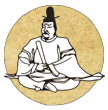
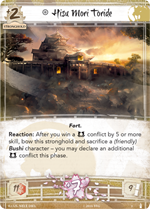


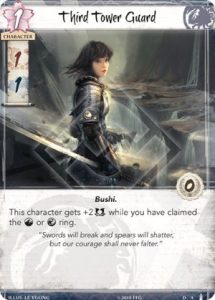
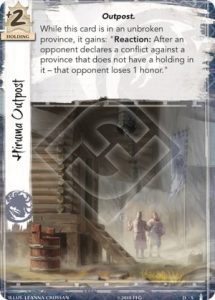

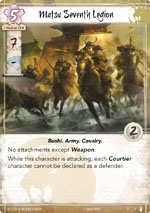

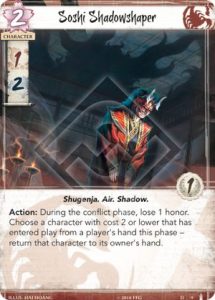

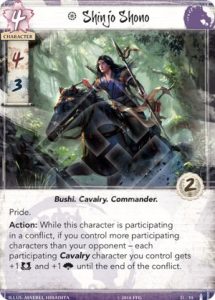
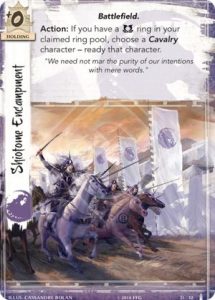
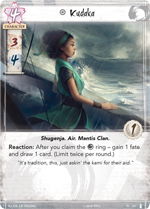

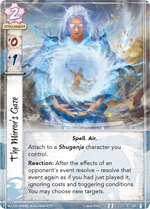
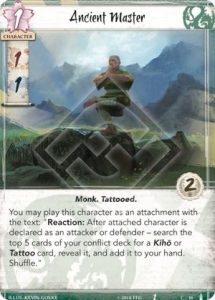
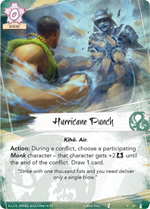
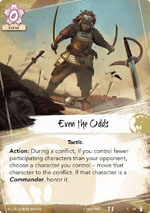

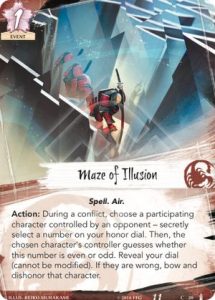
3 Replies to “Elemental Cycle – Pack 1 - Breath of the Kami”
Great review thank You 🙂
Thanks for the article.
Small suggestion – can you add the marks for each card, just like it was in cardgamedb articles? Something like 5 – great card, staple in the decks, 1 – pure garbage, waste of paper.
We intentionally avoid a simple rating and instead focus on the uses of a card. Mostly it’s because we are terrible at this game and don’t want to put it in writing, but also because a cards value with change depending on the card pool and the environment. If you’re looking for a snap shot on whats good or not, we normally call out the highlights in the last paragraph.